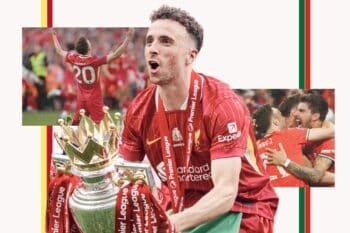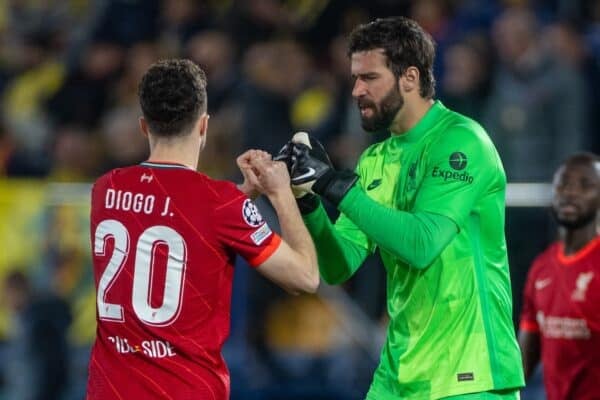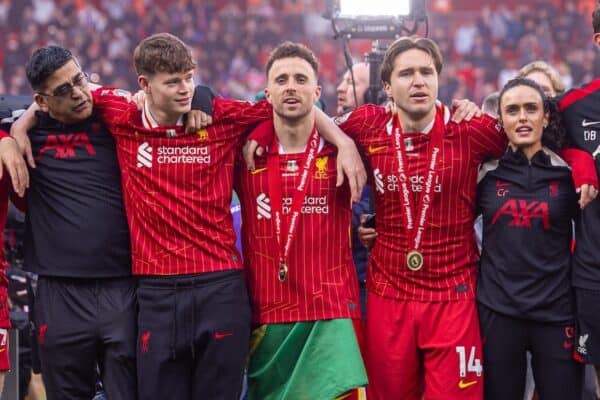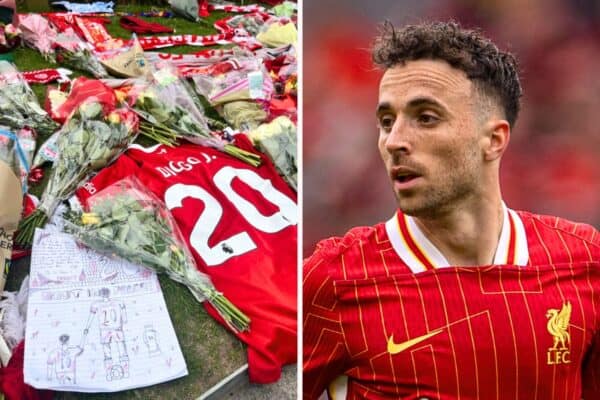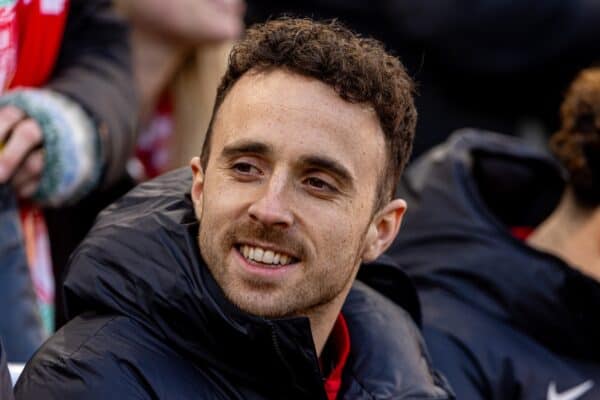Robbie Fowler is my favourite player. In fact, Robbie Fowler is my all-time hero. For what the ‘˜Toxteth Terror’ represents is far more than your everyday, average, run-of-the mill footballer.
It is hard, and often frustrating, to describe to rival supporters just what the man means to Kopites. Whoever coined the nickname ‘˜God’ has the right idea. So too does anyone lucky enough to stand on the Kop and fully appreciate his incredible talents. But Fowler to me and every other reds fanatic is immortal. His story boasts mythical elements. The local-boy made good. A true scaly blessed with a talent so raw, so instinctive, it took him to the very summit of European Soccer. Cynics point to the fact this ability was squandered, tragically cut-short in the vein of Best and Gascoigne before him. Maybe so, but Robbie has never, and will never lose the magical rapport he enjoys with those Liverpool fans who hang on his every word.
A fairytale if ever there was one, Robert Bernard Fowler grew-up on the notoriously rough streets of Toxteth, Merseyside. A mere adolescent when the infamous riots unfolded here, Robbie Junior initially followed the trend of his father and aligned himself with the Blue half of the city. The precocious attributes which would eventually provide his glory-laden career path were easily identifiable. Despite not yet in his teens, Robbie Ryder, as he was known at this time, began shredding goal records and manifesting the hottest of reputations. Sure enough, the big-boys soon came calling. LFC owe a great deal to Jim Aspinall for persuading a monumental transfer in ties. Fortunately, the late scout convinced his newest find to convert, and a beautiful relationship was born.
Years spent as a YTS coincided with a seemingly unstoppable rise in goal scoring exploits. Representation at all youth levels and then reserve status, sparked clamour for inclusion in a struggling Graeme Souness First Team. Perhaps regretfully, the under-fire manager resisted the temptation to blood Fowler until the 1993/94 campaign. When he did, he was not let down.
 A debut strike against Fulham in an otherwise forgetful League Cup tie was an inclination of what was to follow. Any concerns over a flash-in-the-pan beginning were duly quelled with a five goal haul in the return leg at Anfield a fortnight later. 18 goals in all was a highly impressive return that year.
A debut strike against Fulham in an otherwise forgetful League Cup tie was an inclination of what was to follow. Any concerns over a flash-in-the-pan beginning were duly quelled with a five goal haul in the return leg at Anfield a fortnight later. 18 goals in all was a highly impressive return that year.
It was to get even better though. Tallies exceeding 30 were notched in each of the following three seasons. A Coca-Cola Cup winners’ medal was complimented by two Young Player of the Year accolades for 1995 and 1996 respectively. The legendary Ian Rush, whose tutelage became apparent with every game, admitted his record was now under serious threat from this newest predator.
Fittingly, the apprentice donned the shirt of the master after Rushie’s emotional move to Leeds. The number 9 would now become ingrained in the Robbie Fowler story.
In truth, on the pitch there was very little to shout about during this stagnant decade. Yes, fresh impetus and hope arrived courtesy of the likes of Steve McManaman, Jamie Redknapp, Dominic Matteo and Stan Collymore ‘“ but a defence as fruitful as a Steve Brookstein pop career frequently infuriated. Aside from the aforementioned League Cup triumph, an FA Cup runners-up performance was all Roy Evans had to show for his admirable stint in charge. Without the ‘˜Growler’, those accustomed to never-ending success may have slumped into irreconcilable depression.
A changing of the guard was inevitable. David Moores opted for Gerard Houllier, a decision Fowler would live to deplore. Rightly or wrongly, the Frenchman was hell-bent on breaking-up the nucleus of Evans’ team. This spelt bad news for Robbie and his ‘˜Spice Boy’ companions. By the time Rafael Benitez seized control, Michael Owen and Jamie Carragher were the only two surviving members of that 1998 side.
The former presented yet more encouragement. Steve Heighway had prospered once again and now Anfield housed England’s two best strikers. Unfortunately, the famous stadium was soon to play host to one not so gifted. For all his endeavour and hints of promise, Emile Heskey was never in the same class as Owen or Fowler. Nevertheless, this did not stop his coach from utilising the ex-Leicester man as a bollard between the two, hastening a heartbreaking exit.
In fairness, Robbie did not champion his own cause throughout this era. On the pitch, though subject to a bemusing rotation system, he predictably delivered. 17 goals in a Treble winning season earned praise, but a whole host of controversy misted such an achievement.
Most of the national press and football league could not understand the unwavering support for Fowler at this time. Here was a scouser who had enacted the snorting of cocaine, had tormented Graeme Le Saux and dropped his shorts in celebration. While the upper-class snobs of English football jumped on the bandwagon and condemned these actions, Liverpool supporters rallied behind their idol and loved him even more for it. Why? Because he was one of us. Who will ever forget the shirt he wore backing those Dockers harshly sacked in 1997? And what about the time he was caught on tape bad-mouthing Gary Neville in an unfortunate magazine interview?
THAT celebration meanwhile was a way of unleashing years of bottled-up torment. Evertonians, still bitter at the fact one of their own had got away, made brainless accusations of drug abuse, never once producing a slice of evidence. Unlike Michael Owen or Alan Shearer, who sometimes appear as wooden as John Barnes presenting, Fowler is human ‘“ this proved as he comically ‘˜let them ‘˜ave it’.

Just like the top-brass at the FA, Houllier could not grasp such immeasurable adulation. In what became a poisoned series of bust-ups, the icing on the proverbial cake was a famous spat with assistant Phil Thompson. All because of a stray penalty in training, the club captain was hung-out to dry, dropped from the squad and lamented. Despite his Herculean attempt at propaganda though, GH knew where the Kop’s allegiance lie. At the home game with West Ham they sung the name of the prodigal son, no doubt disheartening a desperate Houllier.
Make no mistake, had it not been for the hero-worship reserved for Robbie Fowler, Gerard Houllier would have sold him years earlier. Instead, he was forced to wait until November 2001 before he could sanction an £11 million sale to Elland Road.
I cried three times that day. I was not alone. I know of Liverpool fans who turned their back on the side that fateful winter by way of protest. In spite of plentiful rumours, we always clung to the belief Robbie would stick it out at Anfield. Clearly, the management had come to the end of their tether, and an underhand mission to complete his leaving unfolded for months. It takes a committed man to prolong ones career with a club when that level of discontent is circulating. It was with a heavy-heart that Fowler departed, like his mentor, for Leeds.
Four years in the wilderness unravelled. But forget what the cynics say, Fowler was excellent at Leeds. 14 goals in 30 games is prolific. This figure would have heightened if it were not for the ridiculous circus surrounding the Yorkshire club at the time. At Manchester City however, it was evident the original player had lost his way. Do not though underestimate his goal return. An average of one in four still matched that of Heskey’s, who remained the England centre-forward.
The occasional flash of brilliance would also materialise once in a blue moon (no pun intended), usually against Manchester United. Nonetheless, Stevie Wonder could tell that Fowler yearned for home. At Liverpool he was God. Elsewhere ‘¦ he was one cog in a big machine.
January 28th, 2006, ranks alongside Istanbul as one of the happiest moments of my time following Liverpool Football Club. This was the day Rafa Benitez snapped-up a world class striker on a free transfer. It was the day supporters leapt-up in joyous celebration at a fantastic acquisition. You would have been forgiven for thinking Ronaldinho had stepped foot inside Anfield to sign a contract. No … this was better. God had returned, the second coming was upon us.
An analysis of the last 18 months does not match that of the first nine years, it was never going to. But even so, in the limited play-time reserved for Fowler, he has matched the scoring levels of Fernando Morientes, a £6 million signing from Real Madrid. Whatever his condition, club or age ‘“ he has always been capable of finishing. Nobody comes close in this department.
People may ask if it is upsetting to witness Robbie Fowler nowadays, a shadow of his former self. My answer is always no. This is because every time he sets foot on that hallowed turf I clench my fist and cheer with an inner delight.
All fans possess their own treasured Fowler memories. I, understandably, cherish many. But one in particular, seldom receiving much nostalgic reference, is above all others in my personal reckoning. It came in March 2001 as Liverpool beat United 2-0 at Anfield. Steven Gerrard had already hammered home what would go on to be voted the club’s best Premiership goal. 25 minutes later, on the stroke of half-time, Robbie brought down a Danny Murphy cross on his chest inside the area. Try though he may, captain irritant, Gary Neville, could only slide across the grass in anguish. The scene was set, and Fowler rifled into the roof of the net past a despairing Fabien Bartez. This alone was pure quality but what came next will stay with me forever.
Fowler casually strolled across to those Mancunian supporters camped in the away section of the ground. Instead of celebrating wildly, as he’d be forgiven for doing, he simply stared at them with a clenched fist ‘“ motionless. After about five seconds he let out the most sinister of grins. A smug smile that said it all.
Robbie Fowler is the greatest Liverpool player of all time. I shall miss him no-end. Just hearing his name called-out on the tannoy reminds me of so many amazing times. Thank you for the memories ‘“ here’s to a true legend.
Aaron Cutler


